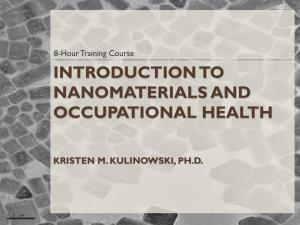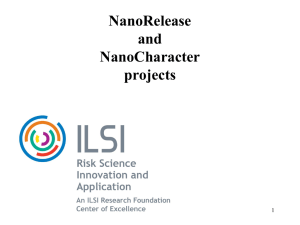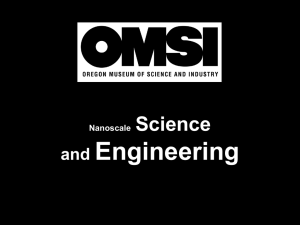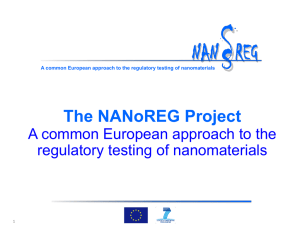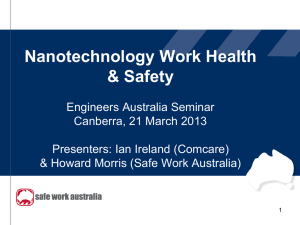Document
advertisement
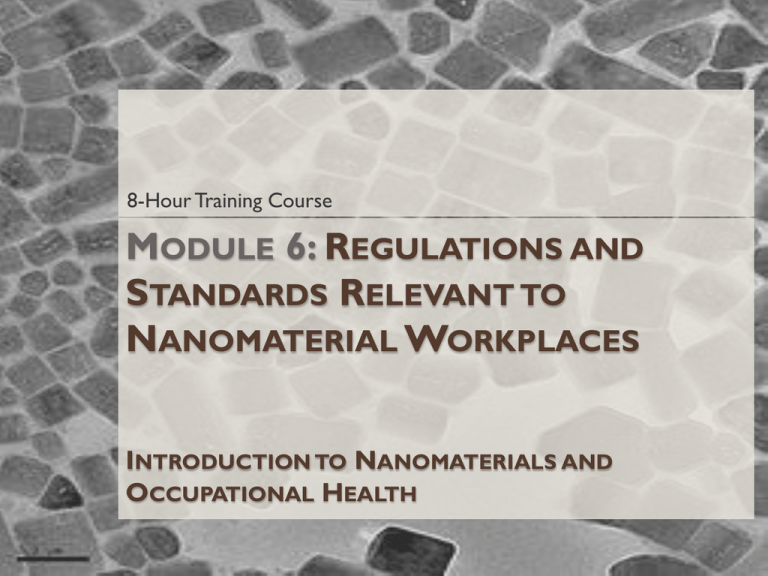
8-Hour Training Course MODULE 6: REGULATIONS AND STANDARDS RELEVANT TO NANOMATERIAL WORKPLACES INTRODUCTION TO NANOMATERIALS AND OCCUPATIONAL HEALTH Eight-Hour Training Course Module 1 Introduction to Nanotechnology and Nanomaterials Module 2 What Workers Need to Know about Nanomaterial Toxicology and Environmental Impacts Module 3 Assessing Exposure to Nanomaterials in the Workplace Module 4 Controlling Exposure to Nanomaterials LUNCH Module 5 Risk Management Approaches for Nanomaterial Workplaces Module 6 Regulations and Standards Relevant to Nanomaterial Workplaces Module 7 Tools and Resources for Further Study 6-2 Lesson Overview Purpose To provide workers with introductory information about standards and regulations relevant for nanomaterial workplaces Topics 1. US regulatory activity in nanotechnology 2. Canadian regulatory activity in nanotechnology 3. Standards developed for nanomaterial handling 6-3 Learning Objectives At the end of this module you should be able to Summarize major developments in nanotechnology regulation in the US and Canada Articulate other standards that are applicable to nanomaterial workplaces 6-4 Recent Regulatory Actions by Sector Foods/ Ag European Commission C Chemistry & Materials Cosmetics A A France B B C Medicinal products & medical devices Occupational issues (OSH) Environment Cross sectoral (nanomaterials, nanotech in general) A A A C A A A B Germany A A A The Netherlands A A A Switzerland A A United Kingdom A USA A A A A B A A A Canada A B A A Australia A B Japan C A Other Countries A A A A A A B A A C A A C A A A A A. Provide guidance to support safety assessment. B. Adapt/strengthen premarket notification procedures. C. Introduce amendments and changes to existing legislation. http://www.observatorynano.eu/project/filesystem/files/ObservatoryNano_Nanotechnologies_RegulationAndStandards_2012.pdf 6-5 Topic 1 US REGULATORY ACTIVITY IN NANOTECHNOLOGY Most Relevant US Government Agencies Regulatory Environment Fund or Perform Risk Research Food & Drugs Worker Safety Consumer Products Food 6-7 History of OSHA OSHA stands for the Occupational Safety and Health Administration, an agency of the U.S. Department of Labor OSHA’s responsibility is worker safety and health protection On December 29, 1970, President Nixon signed the OSH Act This Act created OSHA, the agency, which formally came into being on April 28, 1971 6-8 Applicable OSHA Standards Occupational Safety and Health Act of 1970 (29 U.S.C. 654) General Duty Clause Section 5(a)(1) requires employers to “furnish to each of his employees employment and a place of employment which are free from recognized hazards that are causing or are likely to cause death or serious physical harm to his employees.” Section 5(a)(2) requires employers to "comply with occupational safety and health standards" promulgated under this Act. 6-9 What Rights Does a Worker Have Under OSHA? A worker has the right to: ◦ ◦ ◦ ◦ ◦ ◦ ◦ ◦ ◦ A safe and healthful workplace Know about hazardous chemicals Information about injuries and illnesses in your workplace Complain or request hazard correction from employer Training Hazard exposure and medical records File a complaint with OSHA Participate in an OSHA inspection Be free from retaliation for exercising safety and health rights 6-10 The Right to Know about Hazardous Chemicals Employers must have a written, complete hazard communication program that includes information on: Container labeling, Material Safety Data Sheets (MSDSs), and Worker training. The training must include the physical and health hazards of the chemicals and how workers can protect themselves; including specific procedures the employer has implemented to protect workers, such as work practices, emergency procedures, and personal protective equipment. Very similar to requirements of the Workplace Hazardous Materials Information System (WHMIS) 6-11 OSHA-Identified Nanomaterial Stds 1904, Recording and reporting occupational injuries and illness 1910.132, Personal protective equipment, general requirement 1910.133, Eye and face protection 1910.134, Respiratory protection 1910.138, Hand protection 1910.141, Sanitation 1910.1200, Hazard communication 1910.1450, Occupational exposure to hazardous chemicals in laboratories Certain substance-specific standards (e.g., 1910.1027, Cadmium) 6-12 Environmental Protection Agency Statute Acronym Topic Toxic Substances Control Act TSCA chemical substances Federal Insecticide, Fungicide, and Rodenticide Act FIFRA pesticides Clean Air Act CAA air pollutants Clean Water Act CWA discharge of pollutants into the navigable waters Comprehensive Environmental Response, Compensation and Liability Act CERCLA uncontrolled releases of hazardous materials Resource Conservation and Recovery Act RCRA solid or hazardous waste 6-13 Some Branches on TSCA Decision Tree Is it a chemical substance; i.e., does it have a particular molecular identity? Is it already listed on the TSCA inventory in a non-nanoscale form? Is it exempt because it is an intermediate, impurity, or produced in very low volume? 6-14 Substances EPA Recognizes as Distinct Feature Molecular formula Example C2H6 EPA Verdict C3H8 DIFFERENT Isomers DIFFERENT Crystal Structures DIFFERENT Allotropes DIFFERENT 6-15 Substances Defined to be the Same Featu re Exam p le EP A V e rd ict A ggregates o r p a rticles o f kn o w n su b stan ces SA M E N an o scale ve rsio n s o f kn o w n su b stan ces SA M E “Although a nanoscale substance … differs in particle size and may differ in certain physical and/or chemical properties, EPA considers the two forms to be the same chemical substance because they have the same molecular identity.” What It Is What It Does 6-16 Low-Volume Exemption (LVE) Is it exempt because it is an intermediate, impurity, or produced in very low volume? Many nanoscale substances could qualify for an exemption from TSCA reporting and testing requirements if less than 10,000 kg/yr are sold. 6-17 Recent Actions taken by EPA (2010) Designates any use of nanoscale substance as a Significant New Use, which would require 90-day pre-commerce notification (PROPOSED) 2. Requires companies to report production volume, methods of manufacture and processing, exposure and release information, and available health and safety data (PROPOSED) 3. Requires manufacturers to conduct testing for health effects, ecological effects, and environmental fate, as well as to provide material characterization data on certain multiwall carbon nanotubes, and nanoscale clays and alumina (PROPOSED) 1. 6-18 Requirements EPA Has Imposed For certain multiwall carbon nanotubes ◦ Use gloves impervious to nanoscale particles and chemical protective clothing; ◦ Use a NIOSH–approved full-face respirator with an N 100 cartridge while exposed by inhalation in the work area ◦ Distribute the … substance only to a person who agrees to follow the same restrictions Siloxane modified silica nanoparticles ◦ use with impervious gloves or a NIOSH-approved respirator with an APF of at least 10 6-19 Topic 3 CANADIAN REGULATORY ACTIVITY Government of Canada on Nano c.2003 Nanotechnology in Canada presents deficiencies ◦ Absence of a well defined strategy ◦ Poor coordination of research efforts ◦ Insufficient training More research is warranted into the health and environmental effects of nanotechnology There is a need to rethink environmental assessments Certain nanoparticles may have detrimental effects on health ◦ Pulmonary toxicity that is related to surface area ◦ Entry into blood circulation facilitated by small size Public perception will become a problem. Public policy and media strategy must be designed to manage this. There is a need to close the gaps between ◦ Ethics and science ◦ Industrialized and developing countries 6-21 Relevant Canadian Statutes and Regulations Canada Labor Code (R.S., 1985, c. L-2)—Occupational Safety Canada Occupational Health and Safety Regulations (SOR/86-304), especially parts X (hazardous substances), XI (confined spaces), XII (safety materials, equipment, devices, and clothing), and XIV (materials handling) Canadian Environmental Protection Act (1999, c. 33), especially parts 4 (pollution prevention), 5 (controlling toxic substances), 6 (animate products of biotechnology), and 7 (controlling pollution and managing wastes) Hazardous Products Act (R.S., 1985, c. H-3) and the Controlled Products Regulations (SOR/88-66), where such products have nanoscale components Food and Drugs Act (R.S., 1985, c. F-27 ) 6-22 Proposed Approach for a Regulatory Framework for Nanomaterials (2007) Environment Canada and Health Canada propose Phase 1 (started fall 2006) ◦ Continue work with international partners to develop scientific and research capacities (OECD, ISO). ◦ Inform potential notifiers of their regulatory responsibilities under the current framework. ◦ Develop initiatives to gather information from industry on the uses, properties, and effects of nanomaterials. ◦ Consider whether amendments to CEPA 1999 or the NSNR would be needed to facilitate the risk assessment and management of nanomaterials. Phase 2 (starting 2008) ◦ Resolution of terminology and nomenclature by ISO TC229. ◦ Consider establishing data requirements under the NSNR specific to nanomaterials. ◦ Consider the use of the Significant New Activity (SNAc) provision of CEPA 1999 to require notification of nanoscale forms of substances already on the DSL. http://www.ec.gc.ca/subsnouvelles-newsubs/default.asp?lang=En&n=FD117B60-1 6-23 Nanomaterials Under the Canadian Environmental Protection Act, 1999 (CEPA) CEPA: pollution prevention and protection of environment and human health Part 5 deals with assessment and management of new and existing commercial and industrial substances New Substances Notification Regulations (Chemicals and Polymers): Premarket notification to Environment Canada and Health Canada “New” means anything not already on the Domestic Substances List (DSL) Nano is new if it has “unique structures or molecular arrangements” 6-24 New Substances Program Advisory Note (2007-06) ‘The nanoscale form of a substance on the DSL is considered a “new” substance if it has unique structures or molecular arrangements.’ C60 NEW Nano-TiO2 NOT NEW 6-25 Workplace Hazardous Materials Information System (WHMIS) Canada’s hazard communication standard. Key elements: Derives from Hazardous Products Act (administered by Health Canada) and Controlled Products Regulations Implemented through federal, provincial, and territorial legislation Employers must: ensure that controlled products used, stored, handled, or disposed of in the workplace are properly labeled MSDSs are made available to workers and workers receive education and training to ensure the safe storage, handling, and use of controlled products in the workplace 6-26 Topic 3 STANDARDS DEVELOPED FOR NANOMATERIAL HANDLING Voluntary Consensus Standards Standard Developing Organizations produce standards according to a voluntary consensus process. The standards are not binding but can be incorporated into regulations or codes. The standards process can serve as a stop-gap attempt at self-regulation in fast-moving or emerging areas where regulation is not set. 6-28 Other Standards: ISO and ASTM ASTM E2535-2007: Standard Guide for Handling Unbound Engineered Nanoparticles in Occupational Settings ◦ Practical guidance for reducing unwanted exposure to nanomaterials that could pose an inhalation hazard ISO/TR 12885:2008 Nanotechnologies—Health and safety practices in occupational settings relevant to nanotechnologies ◦ Review of state of knowledge with general guidance for occupational practice 6-29 2012: Canada is Deeply Engaged in International Nano Governance Bodies ISO/TC 229 Nanotechnologies:VOLUNTARY STANDARDS • Developing consensus standards for terminology, characterization, and health & safety • Technical Report on health & safety practices in occupational settings • Multi-stakeholder: government, industry, legal, academic, non-governmental • Canada is convenor of Working Group 1 on Terminology and Nomenclature Organization for Economic Cooperation and Development INTERGOVERNMENTAL GROUP • Safety testing on representative set of nanomaterials; development of test guidelines for assessing nanomaterial toxicity • Primarily government officials • Canada chairs Steering Group 5 on Co-operation on voluntary schemes and regulatory programmes 6-30 Learning Objectives At the end of this module you should be able to Summarize major developments in nanotechnology regulation in the US and Canada Articulate other standards that are applicable to nanomaterial workplaces 6-31 Eight-Hour Training Course Module 1 Introduction to Nanotechnology and Nanomaterials Module 2 What Workers Need to Know about Nanomaterial Toxicology and Environmental Impacts Module 3 Assessing Exposure to Nanomaterials in the Workplace Module 4 Controlling Exposure to Nanomaterials LUNCH Module 5 Risk Management Approaches for Nanomaterial Workplaces Module 6 Regulations and Standards Relevant to Nanomaterial Workplaces Module 7 Tools and Resources for Further Study 6-32
